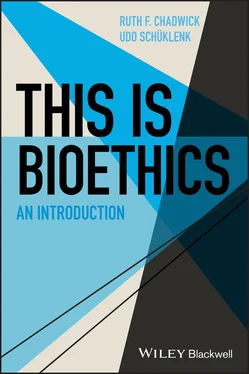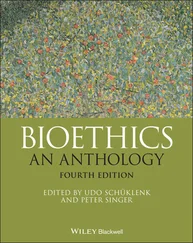21 21 http://plato.stanford.edu/entries/contractarianism/
22 22 http://plato.stanford.edu/entries/contractualism/
23 23https://plato.stanford.edu/entries/justice‐healthcareaccess/
3.1 This chapter provides you with a brief history of bioethics and its scope. We will also look at how bioethicists contribute in ethical review committees to necessary ethics oversight, and in government appointed bioethics commissions to addressing practical policy issues. This matters, because it is at this intersection of policy and bioethics that academic ethicists sometimes wield genuine policy influence. Last but not least we will introduce some commonly used, yet typically flawed arguments, that you will come across frequently in public debates on matters concerning bioethics or biopolicy.
3.1 History and Scope of Bioethics
3.2 No account of the history of bioethics would be complete without mention of a biologist, Van Rensselaer Potter, who is typically – and quite wrongly – credited with coining the term ‘bioethics’ in 1971 (Jonsen 2014, 332). Potter wrote: ‘I propose the term Bioethics in order to emphasize the two most important ingredients in achieving the wisdom that is so desperately needed: biological knowledge and human values’ (Potter 1971, 2). It turns out 1 that the author who actually deserves credit for coining the term is a German Protestant pastor, Fritz Jahr. In 1927 he published an article called ‘Bio‐Ethics: A Review of the Ethical Relationships of Humans to Animals and Plants.’ In that article Jahr aimed to establish bioethics as a discipline as well as a moral principle (Sass 2007). Unlike Potter, Jahr’s work was quickly forgotten during the turbulence of the Second World War. Fast forward from 1927 to 1987. Helga Kuhse and Peter Singer, the founding editors of the leading international journal Bioethics described their fledgling new enterprise in the first issue of the journal this way:
Bioethics will publish articles on the ethical issues raised by medicine and the biological sciences. … The prefix ‘bio’ in our title, then, is used in a narrow sense to refer to the biological sciences, and especially, but not exclusively, the medical and health sciences. It is not being used in the wide sense in which we talk of ‘the biosphere’ to mean all living things, or anything which affects the ecology of our planet. ‘Ethics’ is at least a well‐established term. We understand it to mean the study of what we ought to do, and by ‘ought’ in this context we mean not prudential ‘ought’ of self‐interest, or even group interest, but rather reference to reason or considerations which can be defended from a universal or impartial perspective.
(Kuhse and Singer 1987, iv)
3.3 We will follow in this volume the understanding of ‘bioethics’ that Helga Kuhse and Peter Singer outlined in their journal editorial. For the purposes of this book we understand bioethics as a field of study inquiring into ethical issues arising in the biomedical and health sciences as far as they affect humans.
3.4 It is a legitimate question to ask whether bioethics should also cover ethical issues in our treatment of non‐human animals. Some of the most influential bioethicists 2 have written about the moral standing of animals 3 , not least the just quoted Peter Singer himself, and the morality of using sentient animals for medical research purposes as well as the production of food. We will be touching on this issue, albeit briefly, in the next chapter ( Chapter 4) as well as in the chapter covering issues in research ethics ( Chapter 7). The morality of animal experimentation 4 has been debated controversially for many decades. There are also issues at the interface between species, such as xenotransplantation. You might also wonder why we are seemingly unconcerned about our natural environment 5 . Isn’t the destruction of the Amazon rainforest, for instance, an ethical problem? Well, we are not, strictly speaking, unconcerned, however, what is true is that we will focus in this book on environmental issues only insofar as they affect human health and human well‐being. Environmental ethicists have taken on the task of addressing challenging environmental ethics questions 6 . We shall by and large stay clear of those in this book. Our main focus in the remaining chapters of this book will be – broadly – on challenging ethical questions that arise frequently at the beginning and end of our lives, questions that arise in the context of clinical research involving human participants, the ability of genetic research findings to dramatically change who we are, as well as ethical challenges posed by population and global health issues.
3.5 A lot and very little could be said about the history of bioethics. Historically it certainly grew out of medical ethics 7 . Traditionally medical ethicists were concerned about normative questions that arise in the health care professional patient relationship. Medical ethics covered many clinical ethics 8 issues such as informed consent in the doctor‐patient relationship and professionalism in medicine, but also more contentious issues such as the morality of abortion or euthanasia. It is probably fair to say that varying histories of bioethics as an academic and professional discipline could be written, depending on what country you are looking at. For instance, bioethicist cum historian Robert Baker 9 has written a superb volume on the history of medical ethics in the United States leading up to what he calls, quite appropriately, the ‘bioethics revolution’ (Baker 2013). It is well worth a read if you are interested in how medical ethics evolved over the centuries prior to the rise of bioethics. There are fascinating stories to be found, such as that about J. Marion Sims 10 , the founder of US American gynecology. He shot to fame during his time for the perfection of surgical procedures, but is much more notorious today for achieving this task by undertaking surgery on enslaved African women – without anesthetic or voluntary first person informed consent (Sartin 2004). This might remind you of the kind of ethical relativist questions that we mentioned in Chapter 1, specifically the second type: should J. Marion Sims be judged by the ethical standards of his times or by today’s standards? Well, thankfully this is not actually at issue in this instance. Reportedly one of his competitors, Edinburgh based James Simpson 11 , noted in those same years, ‘I took occasion to make an extensive series of experiments … upon the relative qualities of different metallic threads … [on] a number of unfortunate pigs, which were always, of course, first indulged with a good dose of chloroform 12 ’ (Sartin 2004, 505). He found it appropriate to use anesthetics even on the animals he used for his experimental surgery, very much unlike his colleague in the United States who thought nothing of abusing enslaved African women during his research. The ethical relativism question doesn’t arise then, because Sims’ work was already controversial and criticized by colleagues during his times.
3.6 A few books about the beginnings of bioethics have been written (Jonsen 1998; Rothman 1991; Evans 2012). Not unexpectedly these accounts of the birth of bioethics were not written by philosophers but by professionals hailing from other disciplines. Most of these histories are fairly United States’ centric. Whether they are reflective of how bioethics came of age in other countries or cultural contexts is unclear as these histories still need to be written. Having acknowledged this, North‐American bioethics and its conceptual frameworks have proven to be very influential the world all over. We will stick in this chapter, for the purpose of sketching a brief history of bioethics, by and large to the United States. It is reasonable to assume – with variations – that similar phenomena led to the birth of bioethics in other relatively resource‐rich countries.
Читать дальше












